GOLDMINE
MOUNTAIN
CELLARS WINE BLOG
2011 | ||||||||||||||||||
December 13
- I have some catching up to do. I'm afraid I just haven't found the
time over the last month to update this blog. It's not that I haven't
had wine making notes to share, it's just that between getting ready
for Christmas and taking care of my wines I haven't found the time to
provide any updates. Ok, first things first. About the vineyards... all of my vines at my San Tan vineyard have been fully embraced by dormancy. I continue to have issues at that site though with moles or gophers. I'm not sure which it is but I'm hoping it's moles since they should have little interest in the vine roots. The vines at my Usery Pass location are quickly going dormant but they aren't entirely there yet. The vines at my Superstition Vineyard are a mixed lot; several are dropping leaves but some are still largely green. I've reduced the watering schedule at all three locations to virtually nothing. Beyond that all I can do to hurry dormancy is to prune those vines that aren't quite there yet, as well as pulling their leaves. This is an effective trick when used late in the season, but beware, if you do this too early you may provoke the onset of bud break. Next up I'd like to tell you about my experience with California grapes. I searched high and low this year for Arizona grown grapes to supplement my own production, but to no avail. Every pound of grapes in Arizona was bought up well in advance by commercial wine makers, leaving nothing for the hobbyists like me. So I ended up buying seven pails of frozen crushed grapes from Brehm Vineyards in California. The varieties I chose were all from Bordeaux. Look for a bit more on this subject in this blog in the coming days. November 20 - I'm pleased to report that my 2010 Tres Blancos took first place at the Arizona State Fair. 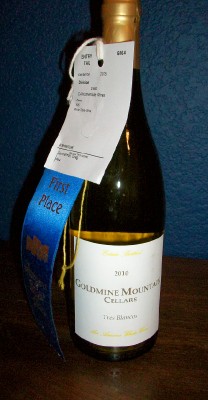 October 30 - All has been quiet in the vineyards and my 2011 wines are resting comfortably in their various carboys and barrels, so I haven't had much to write about lately. This time of the year there's really not much to do in the vineyards, other than checking on the irrigation system and infrequent spraying of fungicides and pesticides. I did recently submit my sixth article for Arizona Vines and Wines magazine. If this article looks familiar there's a reason for that. It's basically a rewrite of a blog post I did several years ago. After struggling to get it down to one page in length (what I'm typically allowed), I learned that they could have accommodated a bigger article this time. Unfortunately I didn't have the time to revise it further at that point. I attended the Arizona State Fair this year, specifically to check out the wine garden and see the amateur wines on display. Here are a few random observations:
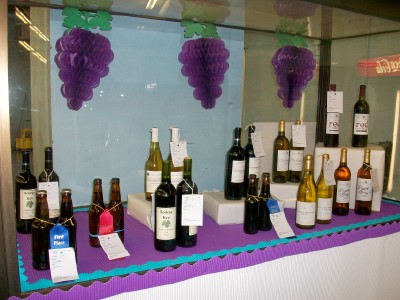 Could it be that only 8 wines and 3 beers were submitted in the whole state? 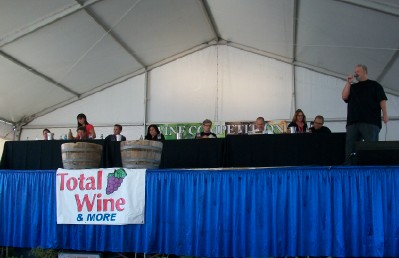 The tasting panel included seven experts. 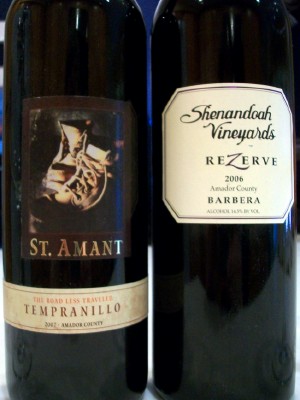 Blending wine can be a very educational exercise. Of course, commercial wine makers do this all the time. I've discussed before the reasons, so I won't delve into this too deeply again. Why am I mentioning this now? Well, I've been thinking more and more about what grapes work in the lower desert and what grapes don't work. Firmly anchored in the "working" category are two reds that I really like, Tempranillo and Barbera. Alone however they don't offer the complexity, structure, and balance necessary to make an exceptional red wine. Together they should have more possibilities. Of course, my Pseudo Tuscan includes both of these grapes but it also includes a number of other varieties, and the ratios are determined at this point not by what works best, but instead by what grapes I have to work with. I was inspired then to pick up a couple of better commercial examples of each to experiment with. Bench trials are typically performed by starting with two wines in three blended samples; the first is 25% the 1st and 75% the 2nd, the second is 50/50, and the third is 75% the first and 25% the second. Once you determine your favorite you can further refine the blend. This is exactly what I did with the two commercial wines I picked up for this experiment. To my palate the best blend was 75% Tempranillo and 25% Barbera. Of course, grapes grown here will be much different than those grown in the more moderate climate of Amador county California, so any attempt to blend finished wines from my own grapes would be an entirely different exercise. Still though, blending can be very educational and it's something I encourage you to experiment with as well. September 11 - I bottled the 2010 Tempranillo yesterday. This was made from grapes sourced from RanchoMaria Vineyards near Benson. 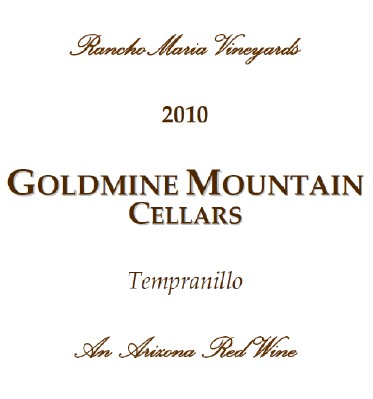 This is the best red wine I've ever made. I'm planning on entering it in the Arizona state fair. 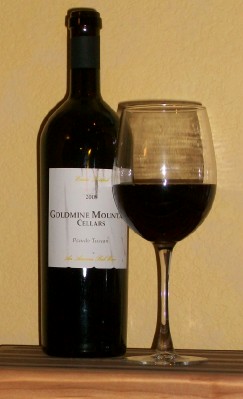 I opened a bottle of my 2008 Pseudo Tuscan this evening. That was the first year I attempted to make this red blend, and by all rights, I should have waited another year. The vines weren't mature enough to produce quality fruit and I didn't have the volume of grapes necessary to make even a small amount of wine. I had to augment it with wine from Cabernet Sauvignon concentrate. If you were to compare this wine to a number of commercial Super Tuscans, this one would come in... dead last. Still though, despite all of its faults, I like it. It represents a beginning... a first attempt, and many lessons learned. August 30 - Fermentation of the Pseudo Tuscan is chugging along nicely. I pitched the yeast four days ago. It ought to be completed soon. I'll probably hold off on pressing for a few days in order to extract more tannin from the grapes.This may require some dry ice to create a CO2 blanket to prevent spoilage. When I pressed the white grapes for my Tres Blancos white blend I didn't add Bentonite. I'd like to tell you that this was part of an experiment to see if I could retain more aromatics, but in fact, I just forgot to add it. Now we're the better part of a month past pitching the yeast, but the wine is noticeabily cloudy and not clearing very fast. It might clear given enough time, but I'm going to add a very small amount of Bentonite at the next racking to help move things along. Maximizing Color in Desert Grown Grapes Our extreme summer heat does nothing for color and tannin development in red grapes. I'm not sure exactly why this is, but I suspect that either the grapes are ripening too quickly to develop normally, or the sun is simply bleaching out the color. Perhaps both explanations are correct. Regardless of the cause, this issue can be addressed. Here's how:
August 23 - After completing several business trips that kept me occupied for the last two weeks, I finally have the time to focus again on my wines. I removed all of my red grapes from the freezers and started my 2011 Pseudo Tuscan. This is my red blend and includes nine different varieties. For 2011 they are:
If you've been following this blog for a while you know that one of the biggest problems with desert grown grapes is a lack of color and tannins. I try to address this by adding tannin pre-ferment in various forms as well as specific enzyme products like Lallzyme EX. I also use Opti-Red but I don't add that until I pitch the yeast. I've found that an extended cold maceration can help as well. August 14 - Well, it's over. I harvested the last of the grapes over the last few days. The last to come off the vines were the Nebbiolo and part of the Tempranillo at my Superstition location, the Petite Sirah at my Usery Pass vineyard, and the Grenache and Syrah from my San Tan vineyard. All of these red grapes have been destemmed and frozen. They will be combined and fermented to make my Pseudo Tuscan red wine in the very near future. With the grapes harvested, I removed the last of the bird netting and reduced the watering schedule to 15 gallons per week per vine. Once the heat breaks I'll reduce the irrigation schedule even further. August 7 - The end is near!!! The end of harvest anyway. In recent days I've done a partial harvest of Petite Sirah at my Usery Pass vineyard as well as a partial harvest of Tempranillo at my Superstition location. I also brought in the last of the Barbera from my San Tan vineyard and all of the Petite Verdot as well. Each year I learn new things. Several vines are producing grapes for the first time this year. Grenache has been a bit of a disappointment. The grapes are showing a lot of damage from the sun (sunburn and dessication), and they aren't developing good color either. Petite Verdot was a variety I had high hopes for, but at harvest each bunch had a number of green and raisined berries. This required a time consuming hand sort. I'm quickly falling in love with Barbera though. This variety had no problem pushing Brix up despite the heat and all in all I saw very consistent ripening. August 4 - A lot has happened in the last few days. I harvested the last of the Muscat at my San Tan vineyard. Those were the last of my white wine grapes to be harvested so I proceeded immediately with pressing them. In addition to my Trace Blancos, which will later be split into two batches, I'm also doing an ad hoc white blend of Himrod, Neptune, and Chardonnay grapes from my Usery Pass location. As I've mentioned before, two of my micro-vineyards are on the property of others, making me a share cropper of sorts. This ad hoc white blend will be given to the owners of that property. I tested the must for each of the blends and here's what I came up with.
The specific gravity is fine where it's at, but obviously an acid addition is required. For pH, the rule of thumb indicates that a move of 0.1 will require 1 gram per liter. I've actually found that with my grapes, about half that amount is pretty close. Contrary to popular belief a minor post ferment acid adjustment can be made, so I can add more later if needed. The acid needs to be up around 7 g/l though, and for the Tres Blancos the two acid adjustment calculations came out a bit different. (I chose not to test the acid on the small ad hoc blend.) To get the acid where it needs to be I should add 2 g/l, but to get the pH down where it needs to be I need to add 3 g/l. I decided to just split the difference and add 2.5 g/l. The ad hoc white blend needs 1.8 g/l to get the pH down where it needed to be. July 31 - Yesterday I brought in the Cabernet Sauvignon at my Superstition location as well as the Zinfandel at my San Tan vineyard. Both were showing good signs of maturity and reasonable Brix levels (22 to 23 and 24 to 25 respectively). The harvest is winding down. I pressed a batch of blackberry wine that I started about a week ago. This was actually two batches; the first included some Concord Seedless and the second included some Syrah and Barbera. I used RC212 and BM4x4 yeasts for these batches... the BM4x4 is a blended yeast that's popular for Italian wines. I was surprised how much of an Italian character it gave this blackberry wine. July 29 - In past years Muscat has done quite well, showing only minimal signs of sunburn or dessication. This year is different... Muscat looks like hell. The grapes were badly sunburned and many were lost. I harvested the few I had at my Superstition location several weeks ago, and I started harvesting those at my San Tan location last night. I had to discard many of the grapes because they were too badly damaged. July 28 - I'm starting to think that I've dropped into an alternate universe, one where Cabernet Sauvignon is harvested before Tempranillo. Every year I've had grapes to harvest, the Cabernet wasn't ready until at least three weeks after Tempranillo, but this year I'll harvest Cabernet first. It's testing out at 22 to 23 Brix, and showing excellent signs of ripeness, so I'll likely harvest the Cab tomorrow. Tempranillo may need another week or more. July 23 - I brought in the last of the Barbera at my Usery Pass location. Brix ranged from 21 to 26 and the grapes were showing excellent signs of maturity. Petite Sirah at my Usery Pass location needs more time on the vine; Brix is only about 19. Tempranillo and Cabernet at my Superstition location are very nearly ready to harvest. I'm seeing signs of dessication but they're holding up fairly well. At my San Tan location I still have some table grapes to harvest, as well as the Barbera, Petite Verdot, Grenache, Syrah, and Zinfandel. Today I started two small batches of Blackberry wine from the berries I harvested just a few months ago. They had been languishing in the freezer since mid-May. One batch is my yearly port-style blackberry wine, and the other will be a sweet (non-fortified) wine for friends. I enhanced the former with Syrah and Barbera grapes and the latter with Concord Seedless. The grapes should help round out the flavor profile. July 22 - I harvested Sauvignon Blanc yesterday at the San Tan vineyard. The Brix was 21 to 23 degrees, and most grapes were showing good signs of maturity. The harvest of table grapes is almost complete. Today I'll check on my Usery Pass location. I'm expecting the remainder of the Barbera to be ready for harvest there. Every year is different. The extreme heat around the first of July stunted the development of some grapes and caused a good deal of sunburn and dessication. This has been a rough year for Muscat. I've lost much of the crop due to the heat. Thompson Seedless has performed exceptionally well though. Tempranillo has matured later than usual. In past years I've started harvest on or before July 4th, but here it is the 22nd and it may be another week or so before I bring in these grapes. July 17 - Harvest continues. I started a partial harvest of Barbera at my Usery Pass and Superstition locations. I also brought in the Syrah at my Superstition vineyard. I didn't even check the Brix on this one... the grapes were showing signs of maturity as well as the first signs of raisining or dessication. I was surprised when I checked the Viognier at my San Tan vineyard. The riper clusters were testing out at 23 to 25 Brix. Not all clusters were that ripe, but I went ahead and harvested it all. I tested the Brix of most of the remaining grapes at my San Tan vineyard. Here are the numbers:
July 7 - I apologize for the lack of updates. I've been on a nearly three week drive around the country. Before leaving I made sure the bird netting was up at all three locations, and someone was keeping an eye on the irrigation situation at each location. I returned home from my trip yesterday to find the Tempranillo at my Superstition vineyard at 19 to 20 Brix, and generally looking quite good. The Himrod and Neptune at my Usery Pass vineyard were at about the same Brix, but as white hybrids I decided that was far enough. These two varieties are considered table grapes, but I'll be using them in a semi-sweet white wine in the style of Riesling or Gewurtztramminer. I'm presently working on my next article for Arizona Vines and Wines. The subject for this one is Oak Barrels and Adjuncts. I think it'll be a good one. June 17 - Quite often when people find out that I grow grapes, they'll tell me that they have a vine or two in their yard, but they've never produced grapes. I respond immediately, "you're not watering them enough." I know that because no one ever does water their grapes enough, unless of course they have read and followed the advice I've offered in this blog. Mid summer each vine needs between 25 and 35 gallons a week. I also advise people to prune their vines correctly. Many will allow their vines to sprawl out over a porch overhang or some other structure. Vines need to be pruned correctly each winter to encourage grape production. The final reason for a lack of grapes is that the variety is just sterile or male to begin with, and will never produce grapes. Some garden centers sell these vines for decorative use, and since they're grown at the same nurseries it's possible for vines to be mislabled. June 5 - With some grapes going through véraison and temperatures well above normal, now is the time to maximize watering. Depending on soil conditions and other factors, this time of the year each vine may require 25 to 35 gallons per week. You can't scrimp on water if you want grapes. Another necessity is bird netting. I started hanging netting yesterday at my San Tan vineyard and I hope to have it completed at all three locations within a week. This subject probably deserves a full article unto itself, but all I have time for at the moment are some quick notes on the subect. Hanging Bird Netting Hanging bird netting is definitely my least favorite vineyard task, but without it I'd have no grapes. You may think that since vineyards in the large wine grape growing regions of the world don't generally use it, you might be able to get by without it. Unfortunately though without it, birds will consume the vast majority of your grapes. In areas where grape vines vastly outnumber birds, they aren't so much of a concern. Nowhere in Arizona can you really get by without it. Here's how to get netting on your vines and stop the birds from wiping out your crop.
May 30 - Véraison!!! My Concord Seedless at my San Tan vineyard is showing definite signs of color. In fact, some of the grapes look almost ripe. Here's the dates for véraison over the last few years:
May 21 - Since my last update I've been busy pruning and hedging my vines in advance of putting up bird netting. Netting is absolutely essential in this environment; without it I'd have no grapes. In order to hang the netting the vines need to be trimmed and tied to the trellises. I've slightly modified my spraying schedule for 2011. In 2010 I had great success in keeping everything under control except for powdery mildew. For that reason I've added Myclobutanil to my spraying program. Disease and Insect Control in the Sonoran Desert, Revisited Prior to 2009 my spraying schedule was sporadic, but mostly sufficient. Aside from a recurring problem with Grape Leafhoppers, everything was kept in check. For 2009, thinking that my previous spraying approach was overkill, I decided to try a "light touch" and spray only when necessary to deal with a specific problem. This was a mistake. I had problems in 2009 with Powdery Mildew and Leaf Skeletonizers that I didn't have before. For 2010, I wanted to proceed with a comprehensive spraying program that would control all of these threats. After a fair amount of research I ended up with a spraying schedule that included a variety of organic and sythetic chemicals. I was largely successful in keeping everything in check, but powdery mildew was still an issue. For 2011 I'm adding Myclobutanil to the schedule. Identify the Enemy The place to start when considering what and when to spray is the particular threats you are dealing with. There's no point in spraying something that is specific to a threat that your grapes will never see. Fortunately, here in the desert the list of potential threats is very short. Diseases like Black Rot and Downy Mildew cannot exist in the lower deserts; our temperatures are too high and the humidity is too low. Also, many of the insects that cause grape growers headaches in the eastern US haven't yet established a presence in central Arizona. The perennial fear for grape growers throughout most of the US is Pierces Disease. This disease is caused by a bacterium called Xylella fastidiosa, and is spread by insects like the Glassy-Winged Sharpshooter. These insects or "vectors" as they're called inadvertently carry the bacterium in their guts and spread it while feeding on sap from grape vines and certain other plants. The bacterium basically cuts off nutrient flow inside the plant, choking it to death from the inside. Once established in a region, the disease is virtually impossible to eliminate. The only option for most grape growers is to either replant with far less interesting varieties that are resistant or tolerant, or simply stop growing grapes altogether. Fortunately, at this point at least, this disease and its vectors are not widespread in Arizona. Glassy-winged Sharpshooters have been spotted in the Senoita wine region of Arizona, but aggressive management practices have kept their numbers in check. Some sources indicate that Pierce's disease has been found in the greater Phoenix area, but maps that show the spread of the disease across the country usually show a question mark over central Arizona. It seems that there may be a few pockets of the disease in the state, but it's not widespread. So the disease and pests that I need to control are Powdery Mildew, Grape Leafhoppers, and Leaf Skeletonizers. I do occasionally see damage to my vines caused by various unidentified insects, but the damage is not significant and if I'm spraying for Leafhoppers and Skelotonizers I'll probably control these others as well. The Chemicals and the Chemistry Next time you're at a party or in a crowd, start talking loudly about how you intend to spray chemicals in your yard or garden. Count the number of dramatic gasps that you hear, then listen for those mumbling under their breath about how environmentally insensitive you are. The word "chemicals" it seems, has become a dirty word. I suppose these concerns are not without merit, after all the widespread use of DDT devastated several species of birds, and the use of Agent Orange in Vietnam during the Vietnam War has been associated with all manner of health problems in returning GI's as well as the Vietnamese people. I think these chemicals and their applications were the exception and not the rule. These chemicals and their side effects were clearly not understood, and their application was extreme. Don't get me wrong. I'd be thrilled if I could get by without spraying anything on my vines, and if I have to spray at all, I'd rather spray something that's naturally occurring and carries a low risk of collateral damage. Unfortunately it doesn't seem that effective organic equivalents exist for the control of all diseases and pests. But lets reconsider the notion of chemicals as a bad thing. After all, water is a chemical, but obviously it's not a problem. The organic insecticides and fungicides that are commonly used can all be classified as chemicals, but no one is suggesting they shouldn't be used. Even many synthetic agricultural chemicals actually carry very little risk of any problems, especially when applied according to the manufacturers recommendations. Remember, the biggest problems with DDT and Agent Orange were with their indiscriminate application and improper handling. Now I'm not suggesting that either of those should still be available. Clearly banning them was the right thing to do, but the lesson here is to follow the directions no matter what chemicals you're using. If you are going to spray anything, synthetic or organic, it's important to understand how it works and what risks are associated with it. Let's consider the chemicals that I'm familiar with and intend to use.
(1) Organic versions of Stylet Oil are available. (2) Although Pyrethrin is naturally occurring, insecticides may use synthetic versions known as Pyrethroids which don't qualify as organic. What Are They? Bordeaux powder is just copper sulfate. It's very effective at controlling blight, mildew, rots, and a variety of other fungal diseases. Neem oil is a vegetable oil pressed from the fruits and seeds of the evergreen Neem tree which is native to the Indian subcontinent. It's effective at repelling many types of insects by making the plant both unpalatable and an unpleasant place to reside. It also helps control mildews, rots, and fungal infections, probably in much the same way that stylet oil works. Stylet oil is simply food grade mineral oil. It controls mildews, rots, and fungal infections by breaking down cell walls. Stylet oil can be combined with some other pesticides or lime to extend it's capabilities. Do your research though before combining chemicals to make your own sprays. Some combinations could produce unexpected results. Myclobutanil is a steroid demethylation inhibitor, specifically inhibiting ergosterol biosynthesis. Ergosterol is a critical component of fungal cell membranes and without it the cells die. Pyrethrins are naturally occurring esters extracted from chrysanthemum flowers that kill insects when concentrations are high enough, and serve to repel insects when present in lower concentrations. Synthetic versions of pyrethrins are called pyrethroids. Carbaryl, available commercially as "Sevin", is a chemical in the carbamate family. What this chemical does to insects is insidious. It's a cholinesterase inhibitor; I'll give you the short version of what that means... as neurons fire in the insect's brain, carbaryl prevents them from turning back off again, basically sending the little bugger into seizures or a full nervous breakdown followed by an untimely death. Imidacloprid is a synthetic chemical introduced in the 1980s that's analogous to nicotine, which itself is actually a naturally occurring insecticide. This chemical is generally applied to the soil or irrigation water rather than the plants themselves like most insecticides. The plant draws the chemical up through the roots and as the insects suck the juice out of the plants or eat the leaves they suffer a severe nervous breakdown not unlike that of carbaryl. While deadly for insects, this chemical is surprisingly benign for most animals. It's commonly used as a treatment for fleas and ticks on dogs, and in lab tests, rats have consumed large quantities of it with no ill effects. You may be wondering why I would use chemicals that overlap in their capabilities. This is actually a good approach because over time insects can build up a tolerance or immunity to any particular insecticide. If you are employing a variety of chemicals this is less of an issue. Collateral Damage and Other Issues The use of some chemicals has unintended consequences. Residual copper sulfate on grapes can cause the production of H2S during fermentation. Both carbaryl and imidacloprid have been associated with colony collapse disorder, the widespread and poorly understood loss of honey bees throughout North America. Fortunately for us, bees have little interest in grape vines, so the use of these chemicals in vineyards carries little risk for the bees. Still though, you shouldn't apply either of these chemicals if bees are active in the area. Another area of concern is marine life. Some aquatic animals (especially crustaceans) are sensitive to both carbaryl and imidacloprid since their nervous systems are similar to those of insects. Care should be taken not to apply either near sensitive marine environments. My Spraying Schedule Although subject to change, at this point I'm leaning towards....
One word of caution about the application of these chemicals and our heat. It's generally inadvisable to apply most chemicals during the heat of summer. We start hitting 100 degrees about mid-May. At that time you should start spraying as late in the evening as possible. Later in the summer as temps exceed 110 mid-day, you should consider discontinuing spraying since night time temps will be too hot for the safe application of many chemicals. Spraying in the heat stresses vines and causes more harm than good. Final Thoughts This seems like a good place for a disclaimer... I'm not a chemist nor do I play one on TV, so don't use this article as a substitute for more authoritative sources. No matter what products you're using, make sure to read and understand the labels. It's also a good idea to study up on your chosen chemicals; there are some excellent resources on line for doing just that. Remember too that organic chemicals are still chemicals and their use may carry certain risks. May 11 - My table grapes are girdled. I finished this task yesterday. Now you may be wondering what's girdling... it's actually a groove cut into the bark around the base of a vine. By cutting a circle into the trunk you prevent carbohydrates produced by photosynthesis from making it down to the roots. Everything is forced into the grapes, thereby making them larger. Commercial table grape vineyards just spray everything with gilberic acid. It accomplishes the same thing but is much less labor intensive. I also dropped quite a bit of fruit on my table grape vines. If you want larger grapes, cut off the bottom half of each cluster. This can be done in tandem with girdling. 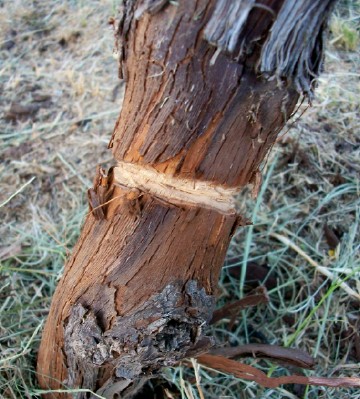 Girdling just requires a groove to be cut in the trunk near the base. 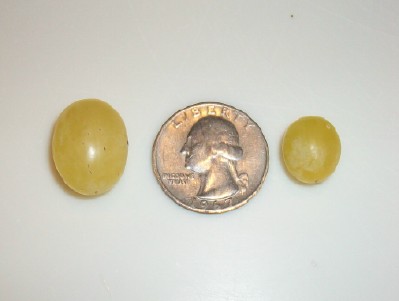 Grape from girdled vine on left, untouched vine on right. As soon as time permits I'll post a refresh of my Disease and Insect Control article from last year. There are a few corrections to make. I'm also working on an article on improving color in desert grown red wines. April 3 - The vines are growing like crazy at all three locations. Like previous years, one of the last varieties to go through bud break was the Cabernet at my Superstition vineyard. I'm a bit overdue on the second spraying of fungicide. Insect pressures are low at this point, but I'm determined to keep powdery mildew under control this year. I'm presently working on my next article for Arizona Vines and Wines. The topic for this article will be on getting started in home wine making. March 7 - Bud break has occured. The first vine this year was a new Nebbiolo at my Superstition location. This vine was just planted late last summer and only grew a little in the fall before dormancy. I noticed this first emerging leaf of the spring just yesterday, March 6th. Now the fun begins. February 14 - THE END IS NEAR!!! The end of dormancy anyway. I'm scrambling to get pruning completed as well as preseason spraying and trellis repairs. Bud break could happen any day now. January 29 - I'm seeing definite signs of swelling buds at my Superstition location. This is early. I don't normally see bud break until early March. I have mixed feelings about this. While on one hand an early bud break would lead to an early harvest, thereby missing some of the worst of our summer heat. On the other hand a longer dormancy period is generally considered important for fruit quality. It's in mother nature's hands though. There's no sense in worrying about things you cannot change. Indications of an early bud break have prompted me to wrap up pruning early. I also need to get my pre-season spraying out of the way. January 17 - In preparation for racking the 2010 Pseudo Tuscan, I tasted a sample tonight. It's probably not good form to speak in glowing terms about your own handiwork, but this wine is fantastic. I'm very satisfied with the way it's turning out. Not all is well though at Goldmine Mountain Cellars. I have a small barrel of Pinot that's gone south. What exactly is wrong with it is unknown, but it likely became infected with something. It doesn't taste like acetic acid (vinegar) but it is quite sharp. I'm going to rack it into unlabeled bottles and give it to my neighbors for use in making sangria or wine spritzers. They already tasted a sample, so they know what they're getting themselves into. | ||||||||||||||||||
2010 Archive | ||||||||||||||||||
| 2009 Archive |
| Home | About Us | Wines | Vineyards | Blog |